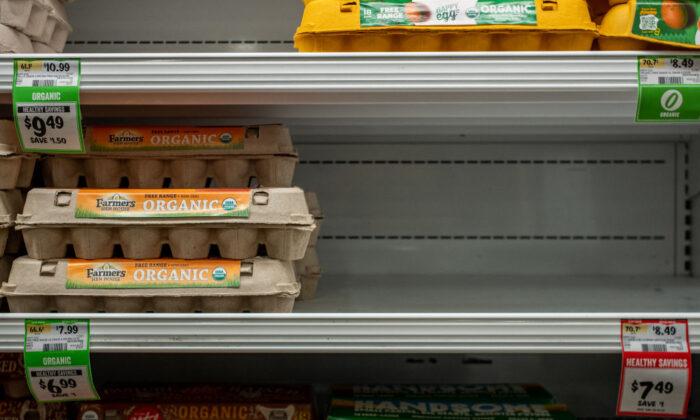On a month-over-month basis, the Consumer Price Index (CPI) rose by 0.1 percent, down from 0.4 percent.
The core inflation rate, which excludes the volatile energy and food sectors, climbed to 5.6 percent year-over-year, up from 5.5 percent. The core CPI jumped by 0.4 percent from February to March, down from 0.5 percent.
Services inflation, which has been stubbornly high, also eased to 7.3 percent, down from 7.6 percent, and is the lowest that the number has been in four months.
The key categories in the CPI report eased from a year ago.
Food prices advanced by 8.5 percent year-over-year. The energy index fell by 6.4 percent. Shelter swelled by 8.2 percent in the 12 months that ended in March.
However, many food items remain higher than last year, such as eggs (36 percent), margarine (33.4 percent), bread (15.2 percent), coffee (10.3 percent), potatoes (9.7 percent), and chicken (6.5 percent).
On the energy front, motor fuel plunged by 4.7 percent month-over-month and 14.2 percent year-over-year. Gasoline prices plummeted by 17.3 percent from a year ago and by 4.6 percent from February to March. Electricity costs were up by more than 10 percent from a year ago, but they slipped by 0.7 percent on a monthly basis. Utility piped gas services also rose by 5.5 percent year-over-year but dropped by 7.1 percent month-over-month.
Rents, which are a lagging inflation indicator, surged by 8.3 percent year-over-year and 0.6 percent month-over-month.
New vehicles rose by 6.1 percent, while used cars and trucks tumbled by 11.2 percent. Apparel increased by 3.3 percent. Medical care commodities and services increased by 3.6 percent and 1 percent, respectively. Transportation services surged at an annualized rate of 13.9 percent.
Investors cheered the news, because it makes the situation less complicated for the Federal Reserve, according to Giuseppe Sette, president of market analytics firm Toggle AI.
“Inflation’s downward trend makes life easier for the Fed,” he said. “However, speculation that the central bank could cut the rate toward the end of the year should be tempered by the Fed’s own communication to the contrary. Traders would do well to remember that rates historically are always higher than inflation except during a recession.”
The financial markets popped following the CPI data before the opening bell, as the leading benchmark indexes were up by at least 0.6 percent in pre-market trading.
The U.S. Treasury market was red across the board, with the benchmark 10-year yield down by about 7 basis points, to about 3.36 percent.
The State of Inflation Expectations
Looking ahead, the Federal Reserve Bank of Cleveland’s CPI Nowcasting expects the annual inflation rate to come in at 5.4 percent and the core CPI to be 5.6 percent in April. The month-over-month CPI is projected to rise by 0.6 percent, and the monthly core CPI is anticipated to climb by 0.5 percent.Alan Detmeister, senior economist and executive director at UBS, thinks it’s still going to take time for inflation to return to the U.S. central bank’s 2 percent target objective.
The IMF thinks inflation will only return to central banks’ targets sometime in 2025.
Despite the bearish tones surrounding inflation, RBC Economics believes that inflation should soften due to a slowdown in food, energy, and rents.
The Producer Price Index (PPI) for March will be released on April 13. Economists forecast a zero percent month-over-month print and a 3 percent year-over-year reading.





